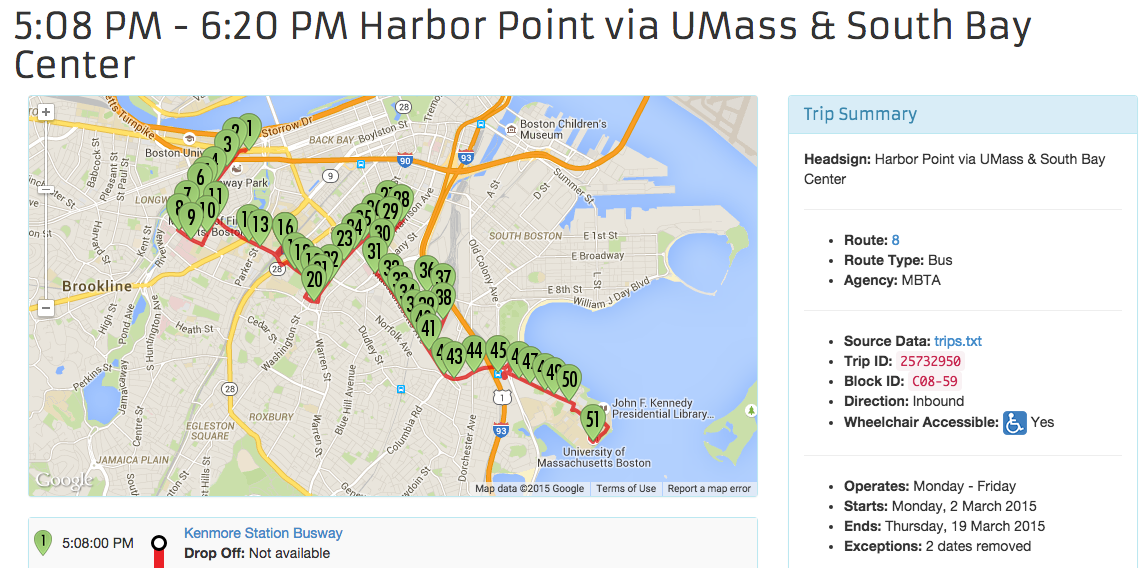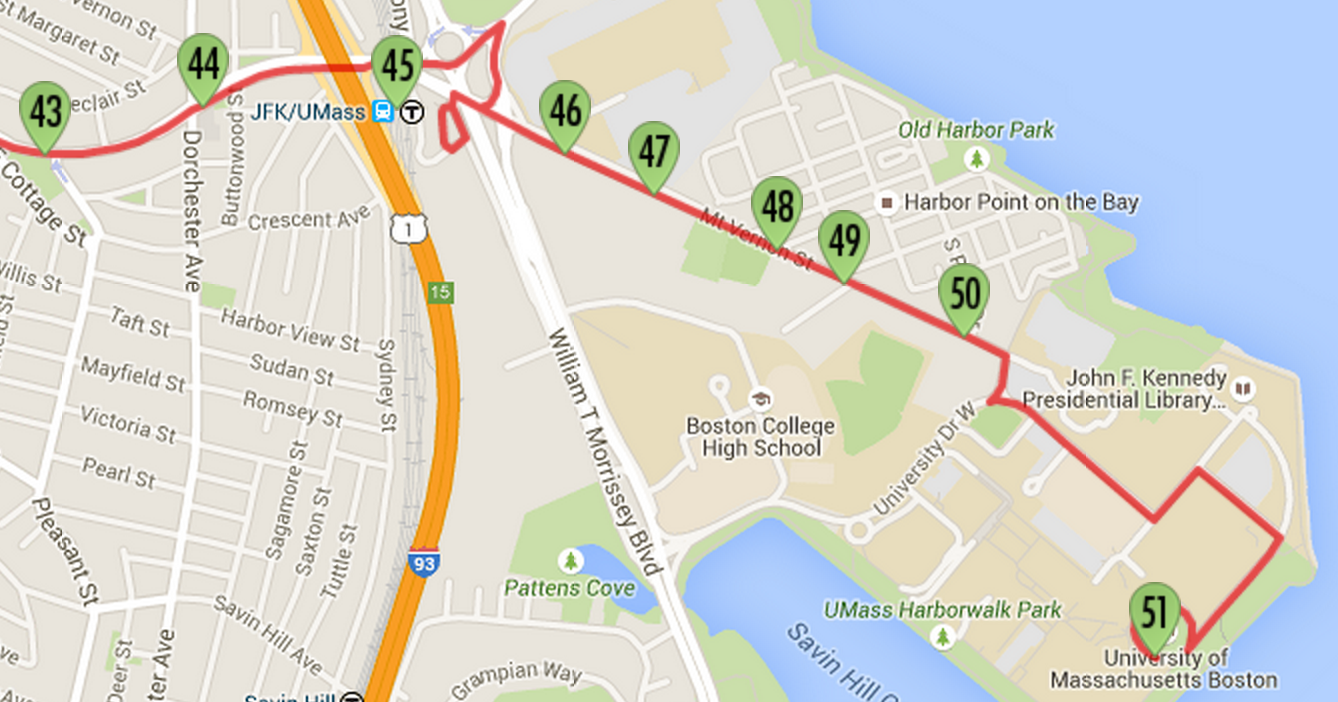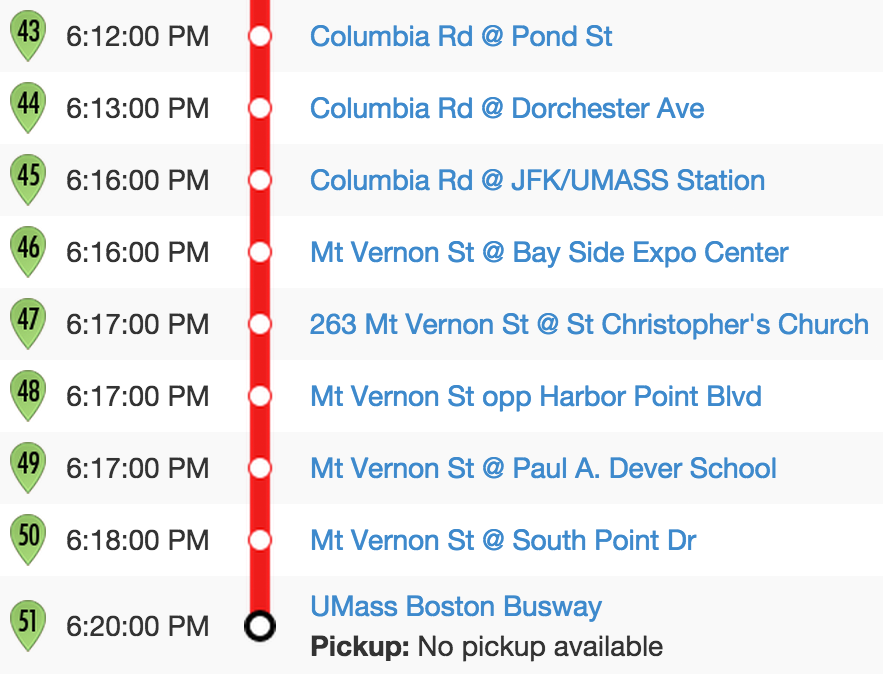4. Introduction to Trip Updates
A trip update message is used to report the progress of a vehicle along its trip. Each trip may only have one trip update message in a GTFS-realtime feed.
A trip update can report that a trip has been canceled, or it can update the progress of any number of stops on the trip. For example, a trip update may contain an arrival estimate only for the vehicle's next stop, or it may contain estimates for every remaining stop on the trip.
If a trip does not have a trip update message, this should be interpreted as there being no real-time information available; not that it is necessarily progressing as scheduled.
Sample Feed
The following extract is from the MBTA trip update feed (https://openmobilitydata.org/p/mbta/91). MBTA also provide separate feeds for service alerts and vehicle positions.
This extract contains a single GTFS-realtime entity, which represents a
bus that is four minutes behind schedule (a delay value of 240
seconds).
entity {
id: "25732950"
trip_update {
trip {
trip_id: "25732950"
start_date: "20150120"
schedule_relationship: SCHEDULED
route_id: "08"
}
stop_time_update {
stop_sequence: 43
arrival {
delay: 240
}
stop_id: "135"
}
vehicle {
id: "y2189"
label: "2189"
}
}
}
Note: This extract has been converted from its binary format into a human-readable version. Outputting Human-Readable GTFS-realtime Feeds shows you how this is achieved.
The elements of a trip_update entity are as follows.
Trip
This element is used to identify the particular trip that a trip update
applies to. In this instance, the trip has an ID of 25732950,
running on the service day of 20 January 2015.

Note: Although this trip may no longer be active, you can view similar trips at https://openmobilitydata.org/p/mbta/64/latest/route/8.
Since the schedule_relationship value is SCHEDULED, this trip
corresponds to a trip in the MBTA GTFS file
(https://openmobilitydata.org/p/mbta/64).
If the schedule_relationship value is ADDED, then this
corresponds to a new trip for the route with an ID of 08. The
stop_time_added field would likely then contain an entry for each
stop on the added trip.
Note: The trip could also be marked as CANCELED. If so, the trip could either be in the GTFS feed or it may have been added through a previous trip update message.
Stop Time Update
The stop_time_update elements contains information specific to a
stop on the trip. It is repeated for each stop that there is information
for. If the trip has been canceled (indicated by a
schedule_relationship value of CANCELED) then there will no
stop_time_update elements.
In the above sample, there is a single update, corresponding to the stop
with an ID of 135. You can look up the details of this stop at
https://openmobilitydata.org/p/mbta/64/latest/stop/135. This stop has a
stop sequence of 43, as shown in the following figure.

Referring to the stop_times.txt file in the GTFS feed, the scheduled
arrival time for this trip at stop 135 is 6:12 PM. The delay value
indicates that it will be four minutes late (240 seconds), meaning it
will now arrive at 6:16 PM.

As there are no additional stop time updates for subsequent updates, it can be assumed that this delay carries through to the rest of the trip. There are eight remaining stops after this one, so all of those will also be four minutes late.
Vehicle
The vehicle information is useful as it enables you to identify specific
vehicles. In this instance, MBTA use the same identifier both as their
internal identifier and also as the identifier printed on the bus. This
sample once again refers to bus 2189. The photograph in Chapter 3: Vehicle Positions
shows how this number appears on the vehicles.
Specification
This section contains the specification for the VehiclePosition
entity type. Some of this information has been sourced from the
GTFS-realtime reference page
(https://developers.google.com/transit/GTFS-realtime/reference).
TripUpdate
| Field | Type | Frequency | Description |
|---|---|---|---|
trip | TripDescriptor | Optional | This element is used to match the referenced trip to trips.txt file from the corresponding GTFS feed. |
vehicle | VehicleDescriptor | Optional | This element provides information that can be used to identify a particular vehicle. |
stop_time_update | StopTimeUpdate | Repeated | This element contains one or more instances of StopTimeUpdate. Each occurrence represents a prediction for a single stop. They must be in order of their stop sequence. |
timestamp | uint64 (64-bit unsigned integer) | Optional | This value refers to the moment at which the real-time progress was measured, specified in number of seconds since 1-Jan-1970 00:00:00 UTC. |
delay | int32 (32-bit signed integer) | Optional | This value is only experimental at time of writing. It is used to indicate the number of seconds the vehicle is either early (negative number) or late (positive number). Estimates specified within StopTimeUpdate elements take precedence over this value. |
TripDescriptor
Identifying a trip in a trip update is slightly different to identifying a trip in a service alert or vehicle position message. With vehicle positions and service alerts, the trip descriptor may refer to an arbitrary trip for a given route, but to do so with trip updates does not make sense.
With trip updates, you must be able to identify a specific trip from the corresponding GTFS feed. This is because trip updates will often only include an update for a single stop, and you must therefore determine subsequent stop times for a given trip so those can be adjusted accordingly. To do so, you need to be able to find a specific trip and its corresponding stop times in the GTFS feed.
This differs to a service alert where you can apply an alert to all trips for a given route, rather than one at a specific time. It also differs to vehicle positions, where being able to see all positions for a route on a map is useful, even if you do not know the specific trip each position corresponds to.
VehicleDescriptor
This element is used to identify a specific vehicle, both internally and for passengers. Every single vehicle in the system must have its own identifier, and it should carry across all vehicle positions and trip updates that correspond to the specific vehicle.
| Field | Type | Frequency | Description |
|---|---|---|---|
id | string | Optional | A unique identifier for a vehicle. This value is not intended to be shown to passengers, but rather for identifying the vehicle internally. |
label | string | Optional | A label that identifies the vehicle to passengers. Unlike the id value, this value may be repeated for multiple vehicles, and it may change for a given vehicle over the course of a trip or series of trips. This might correspond to a route number that is displayed on a bus, or a particular train number, or some other identifier that passengers can see. |
license_plate | string | Optional | The license plate of the vehicle. |
StopTimeUpdate
| Field | Type | Frequency | Description |
|---|---|---|---|
stop_sequence | uint32 (32-bit unsigned integer) | Optional | In GTFS feeds, the order of stops in a trip is indicated by the stop_sequence value in stop_times.txt. If specified, the value specified in the StopTimeUpdate must match the value from the GTFS feed. It is possible for a single trip to make multiple visits to a single stop (for example, if it's a loop service), so this value is important. |
stop_id | string | Optional | This value corresponds to a single stop from the associated GTFS feed. Using this value and the stop_sequence value, it is possible to pinpoint a specific record from stop_times.txt that this StopTimeUpdate element alters. |
arrival | StopTimeEvent | Optional | Specifies the updated arrival time. If the schedule_relationship is SCHEDULED, then this field and/or departure must be specified. |
departure | StopTimeEvent | Optional | Specifies the updated departure time. If the schedule_relationship is SCHEDULED, then this field and/or arrival must be specified. |
schedule_relationship | ScheduleRelationship | Optional | If no value is specified, this defaults to SCHEDULED. Other possible values and their meanings are as described below. |
Valid values for the ScheduleRelationship enumerator are:
| Value | Description |
|---|---|
SCHEDULED | Indicates this stop occurs in accordance with the scheduled trip, although the arrival or departure times may be different from the times listed in the GTFS stop_times.txt file. |
SKIPPED | Indicates that the corresponding stop will be skipped for the given trip. The arrival or departure times may still be included, but the vehicle will not be stopping. |
NO_DATA | This is the value that should be used if no real-time information is available for this stop. In this case, neither arrival nor departure should be specified (if they are, you can safely ignore them). |
StopTimeEvent
| Field | Type | Frequency | Description |
|---|---|---|---|
delay | int32 (32-bit signed integer) | Optional | The number of seconds that a vehicle is early (a negative value) or late (a positive value). A value of 0 indicates the vehicle is exactly on time. |
time | int64 (64-bit signed integer) | Optional | The time of the arrival or departure, specified in number of seconds since 1-Jan-1970 00:00:00 UTC. |
uncertainty | int32 (32-bit signed integer) | Optional | Represents the level of uncertainty attached to this prediction in seconds. A value of 0 means is it completely certain, while an omitted value means an unknown level of uncertainty. |
Either the delay or exact time must be specified. If both are specified,
then the scheduled time in GTFS added to the delay should equal the
time value. If it does not, just the time value can be used.
Conversely, if the delay value is not specified, you can calculate
it by subtracting the GTFS scheduled time from the predicted time
value.
Note: Your interpretation of what constitutes a delay is likely to depend on how you are presenting real-time data. For instance, if you present arrivals to your users as "Early", "On-Time" and "Late", it is likely to be more useful to your users to indicate a 30-second delay as being "On-Time" rather than "Late".
The uncertainty field is used to indicate the accuracy of the
prediction. For example, consider a prediction that indicates a bus will
be five minutes late. If the transit agency thinks the prediction is
within a minute on either side of five minutes (say, 4-6 minutes late),
then the uncertainty value is the difference between the minimum and
maximum value. In this example, the uncertainty is 2 minutes -- a value
of 120 seconds.